Annie Oakley, one of Buffalo Bill
Cody’s Wild West’s star performers, once remarked that William F.
Cody, better known as “Buffalo Bill,” was “the simplest of men, as
comfortable with cowboys as with kings.”
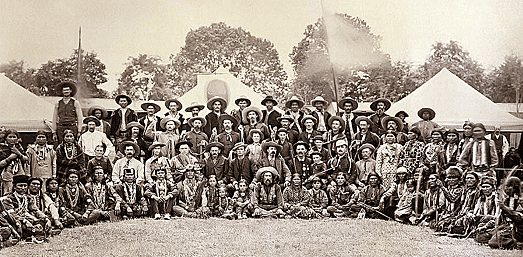
Best known for bringing the Wild West to the folks back East, he was
born in a log cabin near LeClaire, Iowa, on February 26, 1846. The
third of six children, Cody grew up to be an icon of the American
West, respected by everyone from American presidents and British
royalty to military leaders and Indian chiefs. He counted among his
friends such artists and writers as Frederic Remington and Mark
Twain, and charmed the American and European public with a
combination of chivalry and showmanship.
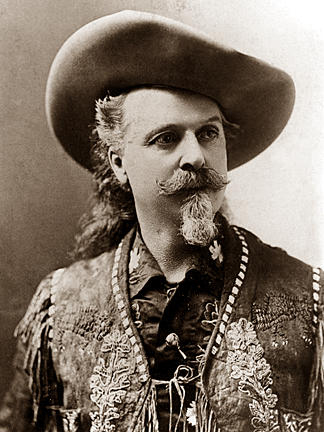 Cody's
family moved to Kansas when his older brother died by falling off a
horse, but tragedy followed them when someone shot his father.
Isaac, while he was making an anti-slavery speech. By age 11, Bill
was the man of the house and his education ended with the fourth
grade.
Cody's
family moved to Kansas when his older brother died by falling off a
horse, but tragedy followed them when someone shot his father.
Isaac, while he was making an anti-slavery speech. By age 11, Bill
was the man of the house and his education ended with the fourth
grade.
At age 12, Cody signed on as a messenger boy with the wagon trains
of Majors and Russell, initially traveling to Fort Laramie. A year
later he was traveling the Oregon Trail to Colorado. His adventures
continued at age 15, when he became a rider for the newly formed
Pony Express.
Following the death of his mother in 1863, Cody enlisted in the
Union Army, serving as a scout for the Union's 7th Kansas Cavalry
during the last years of the Civil War. In 1866, he married Louisa
Frederici. The couple had four children—Arta Lucille, Kit Carson,
Orra Maude, and Irma Louise.
The Birth of “Buffalo Bill”
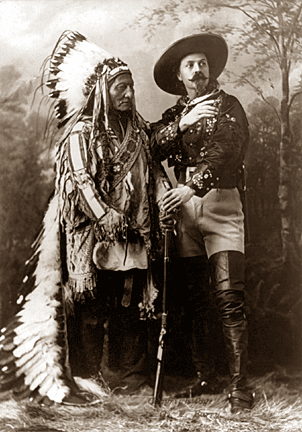 Cody
began hunting buffalo for Kansas Pacific work crews in 1867, where
his reputation as an expert marksman earned him the name “Buffalo
Bill." In 1868, he worked as a civilian scout and guide for the U.S.
Army. In 1872 he became one of only four civilian scouts to be
awarded the Congressional Medal of Honor.
Cody
began hunting buffalo for Kansas Pacific work crews in 1867, where
his reputation as an expert marksman earned him the name “Buffalo
Bill." In 1868, he worked as a civilian scout and guide for the U.S.
Army. In 1872 he became one of only four civilian scouts to be
awarded the Congressional Medal of Honor.
Cody's reputation as a buffalo hunter and skilled frontiersman led
to his eventual career as a Wild West entertainer. Accompanied by
General Phillip Sheridan and Major General George Custer, Buffalo
Bill guided visiting dignitaries on lavish hunting expeditions which
glamorized both Cody and the military. Hearing about Buffalo Bill
and his reputation, dime novel writer Ned Buntline began writing
fictional stories about Buffalo Bill.
In 1872, Buntline persuaded Cody to perform on stage. The success of
the show and Cody's flair for performance led to the formation of a
"combination" troupe the following year. The group consisted of
several authentic Western characters, including James Butler "Wild
Bill" Hickok and Texas Jack Omohundro.
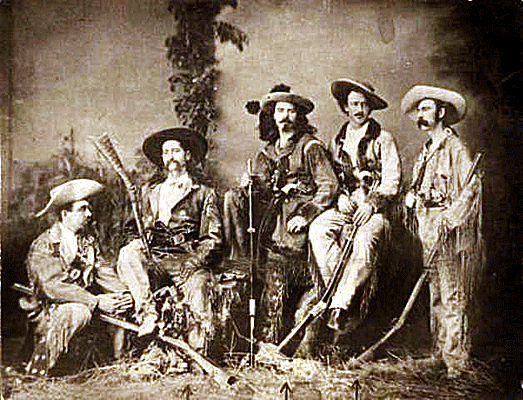
In June 1876, during the height of the Plains Indians resistance to
white settlement, Cody returned to the prairies to scout for the 5th
Army. On July 17, 1876, just three weeks after Custer and the 7th
Cavalry were defeated at Little Big Horn, Cody's regiment
intercepted a band of Cheyenne warriors. In doing so, he proved that
he was more than just another actor.
The Beginning of a Showman
Cody returned to the world of entertainment on July 4, 1882, hosting
a show at his Scout's Rest Ranch in North Platte, Nebraska., which
he purchased in 1877. Promoted with handbills, the show was an
extravaganza of bronco busting, horse racing, riding feats and
shooting exhibitions. Its success prompted Cody to create Buffalo
Bill's Wild West.
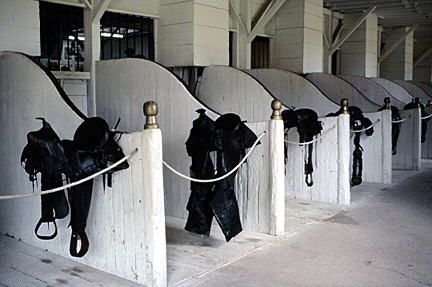 Cody
held his first show in Omaha on May 19, 1883. In it, he offered
something for everyone—bucking broncos, saddle horses, stagecoaches,
animals, cowboys and even Indians, secured by the approval of the
Bureau of Indian Affairs. It proved to be a timeless formula,
lasting for more than 30 years.
Cody
held his first show in Omaha on May 19, 1883. In it, he offered
something for everyone—bucking broncos, saddle horses, stagecoaches,
animals, cowboys and even Indians, secured by the approval of the
Bureau of Indian Affairs. It proved to be a timeless formula,
lasting for more than 30 years.
Cody’s partner that first season was a dentist and exhibition
shooter, Dr. W.F. Carver. Cody and Carver took the show, subtitled
“Rocky Mountain and Prairie Exhibition,” across the country to
popular acclaim and favorable reviews, launching a genre of outdoor
entertainment that thrived for three decades and survived, in fits
and starts, for almost three more.
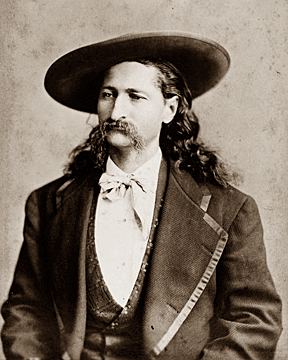 Horse
shows and menageries with exotic animals had been popular in America
since the 18th century. The “Indian Gallery” of artist George Catlin
featured American Indians with native dress and accouterments to
complement his paintings. Medicine Shows employed frontiersmen and
Indian people to help sell tonics and other “natural” cures.
Horse
shows and menageries with exotic animals had been popular in America
since the 18th century. The “Indian Gallery” of artist George Catlin
featured American Indians with native dress and accouterments to
complement his paintings. Medicine Shows employed frontiersmen and
Indian people to help sell tonics and other “natural” cures.
In 1872, legendary plainsman Wild Bill Hickok joined several cowboys
and Indians in a “Grand Buffalo Hunt” staged at Niagara Falls.
Buffalo Bill Cody himself had already been in show business for a
decade, staging plays known as “border dramas,” which actually were
small-scale Wild West shows featuring genuine frontier characters,
real Indians, fancy shooting, and sometimes horses.
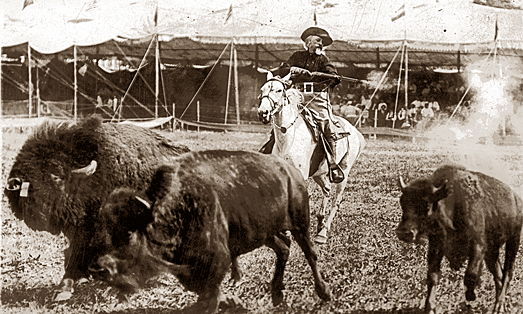
The golden age of outdoor shows began in the 1880s, and with his
theater experience Buffalo Bill already was skilled in the use of
press agents and poster advertising. His fame and credibility as a
westerner lent star appeal and an aura of authenticity. Most
important, Cody gave the show a dramatic narrative structure.
Features such as the Pony Express, the wagon train, or the attack on
the stagecoach recreated specific and well-known events. Spectacles
such as “cowboy fun” or the “tableau” of American Indian life
usually served as prelude to a dramatic event, such as a battle
scene. Skill acts such as sharp shooting with pistol and rifle, wing
shooting with shotgun, roping, and riding not only showcased star
performers, the show’s narration linked those skills to survival in
the frontier West. An orator boomed the script to the audience from
an elevated platform in the arena. The circus band became the
“Cowboy Band” and backed the arena action with appropriate
mood-setting music. The same skits and music later were easily
adapted to film and television “Westerns.”
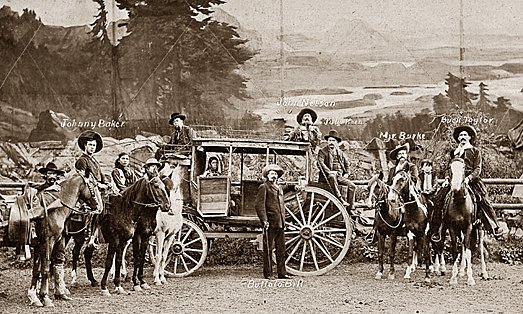
An Eminent Promoter
Buffalo Bill was a savvy promoter. To increase earnings, he started
advertising farewell shows like the “going out of business” sales
some retail businesses use. Although they were popular, his
financial troubles led to bankruptcy in 1913, and the sale of the
Wild West show at public auction.
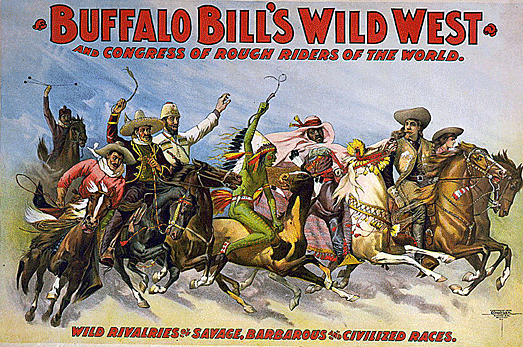
Buffalo Bill understood that the Wild West fascinated people, and he
created a phenomenon by promoting the hell out of it. His passion
for publicity has given us an abundance of great ephemera, including
posters and hand-bills, photographs, cabinet cards and three dozen
different programs.
The role of Indian people was both essential and anomalous in the
Wild West. At least in the big shows, they generally were treated
and paid the same as other performers. They were able to travel with
their families, and they earned a living not possible to them on
their reservations.
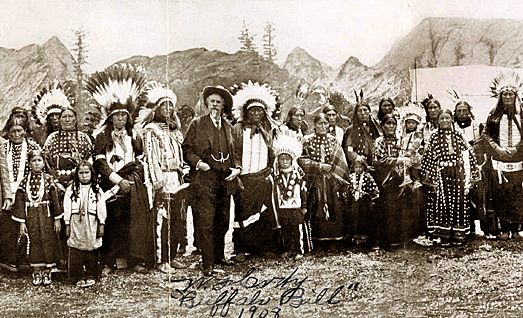
Westward the course of empire takes its way.” In New York’s Madison
Square Garden in 1886, Cody and his partners re-staged Buffalo
Bill’s Wild West as “The Drama of Civilization.” Theater and arena
were now merged, and America’s westward progress thus became an
explicit theme in the show even when it returned to its more
familiar Wild West format.
Star Performers
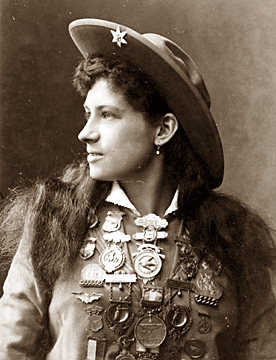 One
of Buffalo Bill’s such performer was Phoebe Ann Moses, alias Annie
Oakley. Called Little Sure Shot by Sioux leader Sitting Bull, Oakley
joined Buffalo Bill in 1885. Although she left the show in 1901, she
was reported to have earned $1 million dollars during her years with
the Wild West. Oakley's act often included her husband, Frank
Butler, who bravely allowed Annie to shoot at a cigarette in his
lips, a dime in his fingers or a playing card in his hand.
One
of Buffalo Bill’s such performer was Phoebe Ann Moses, alias Annie
Oakley. Called Little Sure Shot by Sioux leader Sitting Bull, Oakley
joined Buffalo Bill in 1885. Although she left the show in 1901, she
was reported to have earned $1 million dollars during her years with
the Wild West. Oakley's act often included her husband, Frank
Butler, who bravely allowed Annie to shoot at a cigarette in his
lips, a dime in his fingers or a playing card in his hand.
Oakley was one of the 200 people and 200 animals Cody took to
England in 1887, in celebration of the Golden Jubilee of Queen
Victoria. This was Buffalo Bill's first overseas trip. He brought
along an arsenal of color lithographic posters to advertise the
event. The original show on May 11 was a smash success, and the
Queen the troupe was invited back to do a command performance in
June.
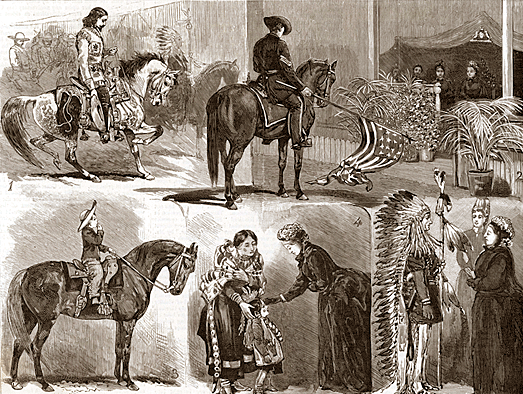
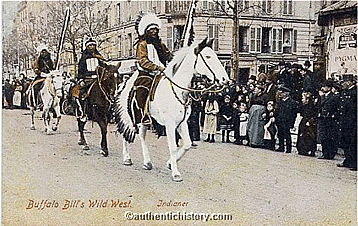 In
1899, Buffalo Bill’s Wild West covered over 11,000 miles in 200 days
giving 341 performances in 132 cities and towns across the United
States. In most places, there would be a parade and two two-hour
performances. Then the whole show would be struck, loaded, and moved
overnight to the next town. Europeans (and their armies) were often
as fascinated by the ingenuity and efficiency behind the scenes as
they were by the show itself. Not many shows could match Buffalo
Bill’s in scale, but all subscribed to similar regimens.
In
1899, Buffalo Bill’s Wild West covered over 11,000 miles in 200 days
giving 341 performances in 132 cities and towns across the United
States. In most places, there would be a parade and two two-hour
performances. Then the whole show would be struck, loaded, and moved
overnight to the next town. Europeans (and their armies) were often
as fascinated by the ingenuity and efficiency behind the scenes as
they were by the show itself. Not many shows could match Buffalo
Bill’s in scale, but all subscribed to similar regimens.
The Wild West in Europe
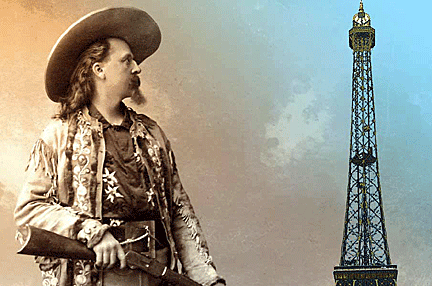 Two
years later, Cody took his Wild West to Paris, once again using show
posters as the principal means of advertising. His 1889 poster, Je
Viens (I'm Coming), announced his tour to the French in grand style.
Two
years later, Cody took his Wild West to Paris, once again using show
posters as the principal means of advertising. His 1889 poster, Je
Viens (I'm Coming), announced his tour to the French in grand style.
The French received the show with
much acclaim, where it ran for seven months at the Paris Exposition
Universelle. The Fair’s management built a grandstand, campground,
and an electric plant to support the show for its extended stay. The
Wild West toured Europe for four years, playing throughout France
and Italy.
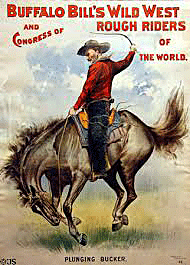 In
1893, Buffalo Bill formed the Wild West and Congress of Rough Riders
of the World, designed to display expert horsemanship from nations
all over the world. The troupe had 640 members, almost 500 horses
and played at exhibition grounds to enormous crowds.
In
1893, Buffalo Bill formed the Wild West and Congress of Rough Riders
of the World, designed to display expert horsemanship from nations
all over the world. The troupe had 640 members, almost 500 horses
and played at exhibition grounds to enormous crowds.
The decade before World War I saw audiences decline. Plus, motion
pictures captivated public attention—the West could seem more real
on the screen than in the arena. Shooting declined as a spectator
sport while the popularity of baseball and football soared. Riding
and roping could be better showcased in rodeos, which were
considerably less expensive to produce than Wild West shows. The old
western stars were fading as well—even Buffalo Bill seemed a
relic—and Indian people appeared to be quietly confined to
reservations. The “old West” was no longer so exotic nor, at the
same time, so relevant to a world of heavy industry and mechanized
warfare.
Cody’s show went bankrupt in July 1913. The era of the Wild West can
conveniently be said to have died in 1917 along with its greatest
proponent, Buffalo Bill Cody.
